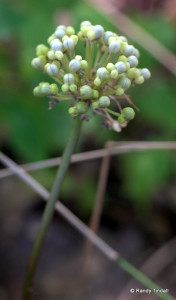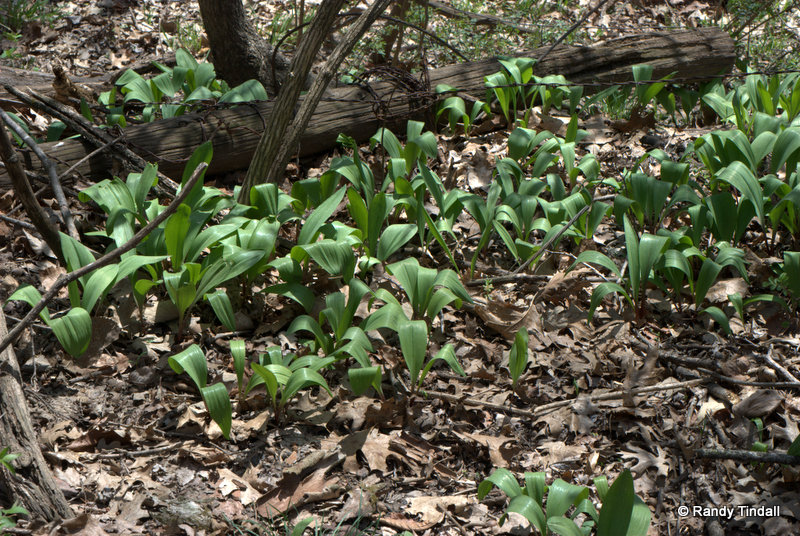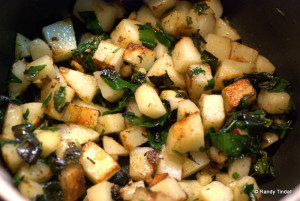What Missouri native is (at least as of last summer) found in our backyard, has a major U.S. city and a river or two named for it, has spawned numerous festivals, and once aroused the ire of the Postmaster General of the United States?
Hint: this same native may also be useful in the prevention and/or treatment of cancer, the common cold, and other ailments, including high cholesterol, and, being notoriously odiferous, some say it may even be effective in the prevention of friends.
We’re talking about the North American wild leek, Allium tricoccum and A. burdicki, also commonly known as “ramps” in Appalachia. Perennial members of the Onion (Alliaceae) family, they grow over much of the eastern United States, west to Missouri, Oklahoma, and the Dakotas, and north into eastern to mid-Canada. In Missouri, wild leeks are reported in 12 counties, including Boone, Howard, and Osage in the central region.
An early riser in spring, the broad, light green leaves are easy to see emerging through the leaf litter, narrowing down to a single white stem that can be reddish or burgundy colored toward the base. The plant has a stalk and bulb quite similar to green onions or scallions. In central Missouri, leaves start developing in early March through April, and after they die back, onion-like flowering stalks with white blooms emerge in June, with seed maturing in late summer. Wild leeks seem to like well-drained, rich, woodland soils with a fair amount of shade.

Seedhead on Wild Leek
In our backyard we have planted a passel of wild leeks in one of our rare patches of good soil, in a fairly shaded area next to a fence. This will be our third year of trying to grow them and, so far, the results are less than encouraging. Unlike most of our natives, the leeks seem to have more exacting requirements in terms of shade and soils. We have observed a couple patches already coming up in February in the wild, but so far there is no sign of ours poking their heads up. We’re keeping our fingers crossed and not breaking eggs for a wild leeks frittata just yet. So do we recommend it for home native plant gardens? Yes, if you have wooded, shady terrain, preferably along a creek, with good soils. Maybe, if you don’t, but want to experiment. The jury’s still out on this one.
Both leaves and bulb are edible, with the flavor and pronounced odor of a combination of onion and garlic, making it a favorite of native plant gourmets throughout its range. Food writer Jane Snow once described the taste as “fried green onions with a dash of funky feet”, a ringing endorsement, if there ever was one. Nonetheless, this smelly plant inspires legions of admirers, ranging from the hill folks of Appalachia to high-end chefs in big city restaurants. It can substitute for onion and, especially, garlic in most any recipe, and they are often cooked with potatoes or in omelets in Appalachia. The leaves can be preserved by sauteing in butter or olive oil, then freezing in zip-lock plastic bags, or they can be dried in a warm oven or dehydrator for later use in soups and stews. They can also be incorporated with basil into pesto (or just skip the basil altogether!) and frozen in ice cube trays or other small containers for future use. Pickling is a good way to preserve the bulbs.
But, be kind. As one commenter noted, “The key to enjoying ramps is to have EVERYONE eat ramps…….Otherwise you can gag on the very air you breathe!” Now, personally, I don’t think they smell that bad, but then I like the smell of strong garlic. At any rate, consider yourself warned.
Also be kind by harvesting them gently and with restraint. The wild leek’s popularity has led to over-harvesting in some areas, and its collection is strictly regulated in parts of Canada. Take only a small portion of a given patch and preferably leave the bulb to sprout again. Personally, when we harvest them from the wild we take only one of several leaves from an individual plant and never touch the bulb. A decent sized patch will give us several large ziplock bags of fragrant leaves, without, as far as we can tell, harming any of the plants. If you have the desire and terrain, you could try propagating the herb. Studies developed by North Carolina State University Extension showed that the best time to establish leek from seed is in late summer to fall under shady conditions.
Now, what about some of those accomplishments mentioned earlier? Seems the Miami Indian word for wild leeks, which were historically abundant around the southern end of Lake Michigan, is chicagoua. The word was also used for the local river system and eventually for the city which sprang up there.
About cancer—-a researcher at Oregon State University suspects that ramps may help prevent some types of cancers by providing selenium in the diet, which it takes up from the soil in amounts greater than its other smelly relatives.
As for the postal service fracas, a newspaper called The West Virginia Hillbilly often featured articles on ramps. Inspired by “scratch and sniff” ads, founder Jim Comstock decided to highlight an issue announcing a local ramp supper by adding the plant’s juice to the printer’s ink. They accomplished their goal of getting noticed, particularly by the Postmaster General, who reprimanded the publishers and made their newspaper possibly unique in the country in being under oath to the government not to—literally—stink.
Nadia’s Potatoes with Wild Leeks
Ingredients
1 tsp butter or olive oil
1 cup wild leek leaves, cut in pieces
1 medium size russet potato or sweet potato-cut in cubes
1 tsp diced fresh ginger
½ cup milk
Pinch of salt
Pinch of nutmeg
Cilantro-optional
Preparation: Add oil or butter to a pan at medium heat, toss leek, potato, ginger, and salt for 5 minutes. Add milk and let potatoes simmer for 20 minutes or until potatoes are soft enough to eat. If you want to skip the milk, cook potatoes a little longer. Garnish with cilantro and eat. Be careful where you breathe.





Any tips on growing in Eastern Washington close to the Canadian border, either in an established garden where there is shade or in tubs? I have a fairly large area where Viola adunca has volunteered and thrives.
Thank you.
Larry
Larry, I can’t personally help you, but I can tell you that there is a wild leek/ramp population in Quebec. It is now restricted due to overharvesting, but I but I couple internet searches could find some info on northern ramp growing.
I know Quebec’s climate is different than yours, but it may help. Other than that, I might speculate that the Pacific NW climate isn’t friendly to ramps, if they aren’t found locally. Let us know! And thanks for reading!
CONSERVE THEM…the proper way to harvest is not all, always, cut one half bulb, leave roots and lower bulb and recover with soil….OTHERWISE THEY WILL NOT COME BACK…and that would be an eternal shame…..
Agreed! We only take a few of the leaves, almost never the bulb. We also grow our own in two plots in our backyard.